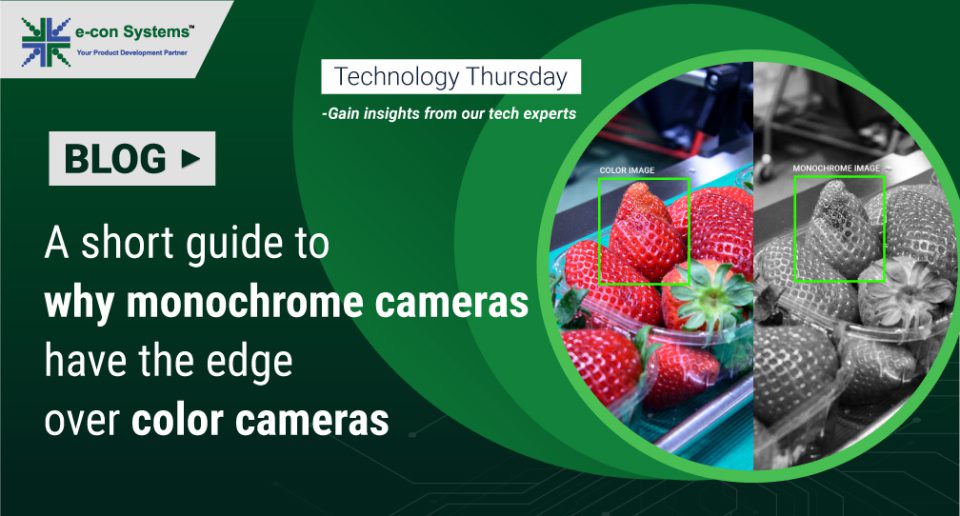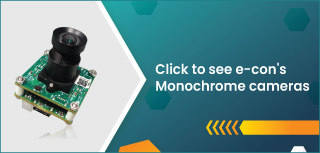Over the years, color cameras have gained popularity as the most viable option for imaging purposes. However, the reality is that for certain embedded vision applications, monochrome cameras with reliable sensors are a much more practical and effective solution. The reason is that monochrome cameras are capable of capturing images with great details and sensitivity when compared to color cameras. But, of course, that’s just to put things in a nutshell.
Understanding why monochrome cameras have several advantages over color cameras requires a closer look at their sensor technologies. In this article, we give you an overview of the key differences between monochrome and color cameras. And we also provide insights on why monochrome cameras are more advantageous than color cameras.
First, let us understand how color and monochrome cameras work.
How do color cameras work?
Color cameras capture only one of several primary colors in an alternating pattern at each photosite. The most common pattern is the Bayer pattern, which uses alternating rows of red-green and green-blue filters. Each pixel captures only 1/3 of incoming light in the Bayer pattern – any color not matching the pattern is automatically filtered out. So, for instance, any red or blue light that hits a green pixel will not get recorded.
Only one color is measured directly at any photosite, while the other two are inferred. This process of combining photosites to produce full-color pixels is referred to as “demosaicing”.
How do monochrome cameras work?
Unlike color cameras, monochrome cameras capture all the incoming light at each pixel – irrespective of color. Since red, green, and blue are all absorbed simultaneously, each pixel can receive up to three times the amount of light. Also, it is important to know that monochrome sensors – unlike color sensors – do not require demosaicing to create the final image.
Also, since there is no need for an ISP, it significantly reduces the chances of any complications.
3 major advantages of monochrome cameras over color cameras
In comparison with color camera, a monochrome camera has the following advantages:
- Monochrome cameras perform better in low lighting conditions
- Monochrome sensors have intrinsically higher frame rates
- Monochrome algorithms are well-tuned
Let us now look at each of them in detail.
Better low light performance
The key difference between monochrome and a color camera is the absence of a Color Filter Array (CFA). In a monochrome camera, the removal of this optical bandpass filter allows for a greater number of photons to reach the photosensitive surface of the sensor. This results in rendering it more sensitive to light – hence, increasing quantum efficiency.
An example of an embedded vision application where this is helpful is medical microscopes. For instance, See3CAM_CU135M – a 13MP monochrome USB camera from e-con Systems – comes with high sensitivity which makes it perfectly suitable for medical microscopes. To learn more about why this camera is the right choice for medical microscopes, please have a look at the article How e-con’s 13MP monochrome USB camera boosts the performance of medical microscopes.
Another example where a monochrome camera is recommended is iris recognition. e-con Systems’ See3CAM_CU55M – 5MP monochrome USB camera – is designed to fit all the imaging needs of an iris recognition system. To learn more about why this product is the best choice for biometric and iris recognition systems, please visit the article See3CAM_CU55M – the perfect camera for iris recognition systems.
On the other hand, color cameras usually have IR cut filters, which prevent infrared light from generating color aberrations. Without these filters, the red, green, and blue pixels tend to react to various wavelengths in the NIR band – resulting in the generation of strange and inaccurate colors.
Due to the absence of the CFA and IR cut filter in a monochrome camera, each pixel of the sensor can detect a broader spectrum of light. It means the overall performance of the camera gets significantly improved in low-light conditions.
Higher frame rates
For a monochrome sensor, each pixel has minimum 8 bits and a maximum of 12 bits, while a color sensor has a minimum of 16 bits. So, in a color camera, the amount of data that needs to be processed is higher in the minimum bandwidth. It leads to a higher processing time and, consequently, a slower frame rate.
Also, unlike color sensors, a monochrome sensor has a larger bandwidth – and so, the processing time is lesser while the frame rate is higher.
Well-tuned algorithms
It may be that recent advancements in color cameras have been tremendously helpful across industries. But building algorithm models for color images is often complex, and hence at times color cameras are not suitable for edge AI based embedded vision applications.
In the case of monochrome cameras, there are plenty of algorithms available for leveraging AI & ML-powered vision models. They enable state-of-the-art applications to detect objects, determine their shape, predict the direction the objects will go in, and more.
Monochrome cameras from e-con Systems
e-con Systems, with over 19 years of experience as an OEM Camera Solution Provider, has developed a portfolio of monochrome cameras for an array of applications across various industries. Here are some of our most popular and best-selling monochrome cameras.
- See3CAM_CU135M – 4K monochrome USB 3.1 Gen 1 camera
- See3CAM_CU55M – 5MP monochrome USB NIR camera
- See3CAM_20CUG – 2MP monochrome global shutter camera
- STEEReoCAM® – 2MP stereo camera for NVIDIA® Jetson Nano™/Jetson AGX Xavier™/Jetson™ TX2
- e-CAM24_CUXVR – 2MP global shutter monochrome camera for NVIDIA® Jetson AGX Xavier™
Hope this article gave you a good understanding of the advantages of monochrome cameras over color cameras. However, this doesn’t mean that you need to go with a monochrome camera for every applications. If your application doesn’t require a color output, and has sensitivity and low light performance as the most important criteria, then you should go with a monochrome camera.
It is always recommended to take the advice of an imaging partner before you make such a decision. If need any help in picking and integrating the right cameras into your vision based systems, please write to us at camerasolutions@e-consystems.com.

Prabu is the Chief Technology Officer and Head of Camera Products at e-con Systems, and comes with a rich experience of more than 15 years in the embedded vision space. He brings to the table a deep knowledge in USB cameras, embedded vision cameras, vision algorithms and FPGAs. He has built 50+ camera solutions spanning various domains such as medical, industrial, agriculture, retail, biometrics, and more. He also comes with expertise in device driver development and BSP development. Currently, Prabu’s focus is to build smart camera solutions that power new age AI based applications.



